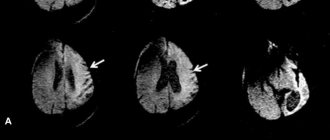Myasthenia gravis is an autoimmune disease that causes muscle weakness. The disease develops due to a disruption in impulse transmission between neurons and muscle fibers. The pathological process develops simultaneously with thymic hyperplasia. More often, the disease is diagnosed in women after twenty years of age, but in some cases it occurs in children, young people and the elderly.
Neurologists at the Yusupov Hospital diagnose myasthenia gravis using modern instrumental diagnostic methods. The latest medications and non-drug therapy methods are used for treatment. Specialists at the physical rehabilitation clinic individually create a set of gymnastic exercises that help increase muscle strength.
Causes
Scientists identify two main causes of myasthenia gravis: congenital gene pathology and exposure to provoking factors.
The congenital form of the disease is associated with a mutation in the patient’s genome, as a result of which the transmission of information through synapses (special adapters that deliver impulses to their destination) stops. The acquired form of the disease occurs under the influence of the following provoking factors:
- Benign or malignant neoplasms;
- Autoimmune diseases (dermatomyositis, scleroderma);
- Inadequate physical activity;
- Constant stress;
- Viral diseases.
The mechanism of development of the disease is as follows: in the human body, the synthesis of special proteins begins, which destroy similar structures. This causes disruptions in the transmission of neuromuscular impulses. Myasthenic crisis develops under the influence of the following factors:
- Injuries;
- Stress;
- Acute infections;
- Some medications.
During pregnancy, symptoms of the disease in women may worsen or disappear.
Expert opinion
Author: Olga Vladimirovna Boyko
Neurologist, Doctor of Medical Sciences
According to the latest data, myasthenia gravis accounts for 0.5-5% of cases per 100 thousand population. Myasthenia gravis affects women 2-3 times more often. In most cases, the disease debuts before the age of 40. Patients with myasthenia gravis become disabled group 1 or 2 in 30% of cases. In Russia, the disease accounts for 2.5% of cases. The exact causes of myasthenia gravis are still unknown. Doctors identify predisposing factors, the presence of which increases the risk of developing the disease.
Diagnosis of myasthenia gravis can be delayed due to the variety of clinical manifestations. The Yusupov Hospital uses the latest equipment to examine patients: CT, MRI, EEG. To clarify the diagnosis, a serological blood test is performed in a modern laboratory. Thanks to an integrated approach, experienced doctors identify myasthenia gravis at any stage of development. An individual treatment plan is developed for each patient. This approach allows you to achieve positive results in a minimum amount of time.
Also at the Yusupov Hospital, relief of myasthenic crisis is available in intensive care and intensive care settings. The drugs used meet safety and quality standards.
Diagnosis of the generalized form of myasthenia gravis
The code for myasthenia gravis according to ICD 10 is G70. The correlation of the defect with autoimmune pathologies occurs after a complete medical examination of the patient. At the first stage, the doctor:
- studies anamnesis;
- examines the patient;
- listens to complaints.
After which the following procedures are prescribed:
- proserine test - allows you to improve the patient’s well-being for a short time, which will indicate a positive reaction;
- electromyography - it is used to study and record the electrical activity of the main muscle group;
- electroneurography - studies the speed of passage of a nerve impulse through the fibers of peripheral nerves;
- blood test for specific antibodies;
- computed tomography of the thymus gland, in most patients its proliferation and increase in size are detected.
After a comprehensive examination, differentiation is required from:
- inflammatory diseases (encephalitis and meningitis);
- tumor-like formations in the cerebral cortex (gliomas, hemangioblastomas);
- neuromuscular pathologies (ALS, Guillain's syndrome, myopathy);
- disorders in cerebral circulation (ischemic stroke).
After completing all the necessary procedures, the preliminary diagnosis is confirmed or refuted. In the first case, an individual therapeutic course is prescribed.
Signs of the disease in adults
Clinical signs of myasthenia gravis may occur sporadically. The rest of the time the patient is in a state of remission (symptoms of the disease are not expressed). This is typical for the ocular form of myasthenia gravis.
You should make an appointment with a neurologist at the Yusupov Hospital if you have the following neurological symptoms:
- Rapid fatigue when chewing food, walking, working at the computer or reading;
- Violation of facial expressions, speech, voice;
- Motor function disorders.
At the onset of the disease, the clinical picture is so unexpressed that a person does not pay special attention to the existing abnormalities. Due to constant employment and heavy workload at home and at work, patients consult a doctor when the manifestations of the disease become noticeable.
Neurologists distinguish 3 groups of symptoms of myasthenia gravis in adults:
- Ophthalmic;
- Muscular;
- Respiratory.
Ocular manifestations of the disease include ptosis (drooping of the eyelid), diplopia (double vision), deviation to the side of the eyeballs when they move. As the load increases, the nervous symptoms worsen, the patient feels a headache and soreness in the eyes.
Muscular signs of myasthenia gravis are manifested by weakness in various muscle groups:
- Hypomimia – weakness of the facial muscles, when the patient has problems puffing out his cheeks, smiling, or closing his eyes;
- Bulbar syndrome - a swallowing disorder, which leads to the patient coughing while eating, choking, nasal during a conversation, and his speech becomes incomprehensible;
- Chewing weakness - the patient has difficulty chewing food, he gets tired quickly, and the disturbance in the eating process is aggravated by drooping of the lower jaw;
- Weakness in the neck and torso - it becomes increasingly difficult for the patient to hold his head, which tilts back or hangs down;
- Weakness in the limbs - due to the fact that the extensor muscles are predominantly affected, the patient experiences powerlessness after heavy exertion.
- Respiratory disorders are manifested by weakening of the muscles of the diaphragm, laryngeal and intercostal muscles. In this case, it becomes necessary to connect the patient to a ventilator. Patients are hospitalized in the intensive care unit around the clock, regardless of the day of the week.
Prevention
This is a serious diagnosis, but with timely treatment, the patient has a great chance of living a full life. It will be necessary to avoid the following provoking factors:
- intense physical activity, which can accelerate the disease and lead to its exacerbation;
- prolonged exposure to the sun, especially under the influence of direct ultraviolet radiation;
- saunas, steam baths, solariums - they lead to overheating of the body, which entails consequences;
- prolonged stress and emotional overstrain;
- constant overwork of the body from prolonged monotonous work at the computer or book;
- taking certain medications.
When visiting your doctor, you should be sure to familiarize yourself with all the medications that are strictly prohibited for people with autoimmune disorders. They can trigger myasthenic crisis and even lead to death.
Forms of the disease
Neurologists distinguish the following forms of myasthenia in adults:
- eye;
- bulbar;
- Generalized;
- Myasthenic syndrome.
The ocular form of myasthenia is manifested by damage to the muscle fibers responsible for the movements of the eyeball, raising and holding the upper eyelid. These functions are disrupted with increasing physical activity, a stressful situation, and after taking anticholinesterase drugs.
The bulbar form of myasthenia is characterized by disturbances in the process of chewing food, swallowing, and speech. The patient's voice becomes hoarse and nasal. Since facial expressions are minimally expressed, it seems that the person looks much younger than his age. His smile resembles a grin.
In the generalized form of myasthenia, all muscles are affected. They are gradually involved in the pathological process. First, the movements of the eyeballs are impaired, then the function of the facial and neck muscles. After some time, the muscles of the musculoskeletal system are involved in the pathological process.
Myasthenic crisis can develop regardless of the form of the disease and the severity of movement disorders. The patient suddenly experiences double vision, severe weakness and impaired activity of the larynx. It becomes difficult for him to speak, breathe, and swallow. The pulse quickens. Salivation increases. In severe cases, the pupils dilate, the heartbeat quickens, and paralysis occurs with preservation of sensitivity.
A rare type of myasthenia gravis is Lambert-Eaton syndrome. The disease is characterized by disruption of neuromuscular transmission. This leads to fatigue, myalgia (muscle pain), paralysis of the extraocular muscle, and autonomic disorders. This syndrome develops in patients with small cell lung cancer and other malignant tumors. Patients often have difficulty rising from a sitting or lying position.
Myasthenia Gravis, or pseudoparalytic myasthenia, develops against the background of dysfunction of the endocrine system and autoimmune diseases - lupus, rheumatoid arthritis. It comes in the following types: congenital, newborn, juvenile, generalized adult myasthenia.
Make an appointment
Symptoms of the generalized form of myasthenia gravis
This type of pathology is more common than others. The generalized form is characterized by the extensiveness of the process; affected areas can be throughout the body.
Clinical signs include problems:
- in the eye area: community of the upper eyelid, double vision, inability to open and close the eyes;
- in the facial area: facial expressions change, they become weakly expressed; an unnatural smile, in the form of a grin; wrinkles appear on the skin; the jaw may sag (which disrupts the process of chewing and swallowing food, and excessive salivation appears);
- in the neck area: the ability to hold the neck and head is lost, which significantly limits the range of vision; it is impossible to sit without special clamps;
- in the extremities: it is difficult to bend and straighten the legs, rapid fatigue does not allow climbing stairs or uphill. Muscle atrophy leads to the inability to move the limbs.
In severe cases, the patient often experiences severe pain while performing certain actions. In addition to external violations, internal ones also occur:
- disruptions in the functioning of the endocrine glands;
- hyperfunction of the thyroid gland;
- adrenal insufficiency;
- problems with electrolyte metabolism;
- cardiovascular defects;
- damage to the gastrointestinal tract;
- disruptions in liver function.
Acute myasthenia gravis leads to defects in external respiration. Under the influence of unfavorable factors - viral diseases, intoxication, physical or mental stress, endocrine or metabolic disruptions - patients experience a myasthenic crisis. Clinically, it manifests itself as a deterioration in health, an increase in the severity of bulbar and ocular disorders.
During a crisis, a gross blockage of neuromuscular patency occurs, which can lead to:
- to bulbar palsy with aphonia, dysarthria, dysphagia;
- to paresis of the diaphragm and intercostal muscles;
- to paralysis of the limbs.
At this stage, the feeling of anxiety intensifies, psychomotor agitation is observed, which is replaced by lethargy and apathy. The main features are added:
- mydriasis - pathological dilation of the pupil with the appearance of increased photosensitivity, decreased visual acuity, burning sensation and fatigue, lacrimation and impaired motor function of the eyes;
- tachycardia - increased heart rate at rest;
- weak pulse - usually indicates the presence of endocrine changes associated with decreased functioning of the adrenal glands;
- dry skin - indicates dehydration, when due to problems with swallowing and increased salivation, the body loses the necessary fluid;
- hyperhidrosis - excessive sweating;
- intestinal paresis - a gradual decrease in the tone of the intestinal wall with muscle paralysis; the patient may experience bloating, nausea, vomiting, and respiratory failure;
- Brain hypoxia is associated with an insufficient amount of oxygen received; this process can provoke coma and death, and loss of consciousness is also possible.
It is worth distinguishing between myasthenic and cholinergic crises. The development of the latter is associated with an overdose of medications based on an anticholinesterase substance. The condition worsens after taking medications, which can lead to respiratory arrest.
Infantile myasthenia gravis
Symptoms of myasthenia gravis in children differ from those in adults. Congenital myasthenia is determined already at the stage of intrauterine development of the fetus: it is almost or completely inactive. After birth, due to the fact that the child cannot breathe, he dies. Neonatal myasthenia is manifested by the following symptoms:
- Lethargy;
- Difficulty breathing;
- A weak cry;
- Fatigue quickly.
- The baby quickly sucks milk. His mouth is constantly slightly open, his eyes are fixed, and swallowing is difficult.
Early childhood myasthenia is diagnosed in children under two years of age. Symptoms of the disease are similar to those of myasthenia gravis in adults:
- drooping eyelid;
- Gaze paralysis;
- Strabismus.
When the respiratory muscles are involved in the pathological process, the child becomes passive. If the masticatory muscles are affected, he may refuse to eat completely.
Childhood and youth myasthenia gravis affects children aged two to ten years. The disease is more often detected in girls. The symptoms are similar to the early childhood type of the disease. The difference lies in diagnosis: it is easier to ask an older child about symptoms, which allows for therapy to be started sooner.
Diagnostic methods
To establish an accurate diagnosis and find out the causes of nerve function disorders, neurologists at the Yusupov Hospital conduct a comprehensive examination of the patient. It includes:
- Patient interview;
- General and neurological examination;
- Palpation, percussion and auscultation;
- Neurological examination.
Doctors at the Neurology Clinic prescribe the following laboratory and instrumental studies:
- Clinical and biochemical blood test;
- Electromyography, which is used to assess muscle condition;
- Genetic screening to determine the presence of a mutation gene in a DNA chain;
- Electroneurography, which is used to check the speed of impulse transmission;
- Magnetic resonance imaging, which provides data on the presence of thymic hyperplasia and tumor-like neoplasms.
A fatigue rate test is also performed. The doctor asks the patient to quickly perform chewing movements with his jaw, swing his limbs, clench and unclench his hands, and quickly squat. When performing a protein test, a special substance is injected under the patient's skin. Within half an hour a person feels a significant physical lift. His fatigue goes away. This condition does not last long. After the drug takes effect, the symptoms of myasthenia gravis return.
The decrement test is a method for studying the process of transmission of neuromuscular impulses. It aims to study five muscle groups. Each of them is exposed to an artificial provocateur, causing rhythmic contraction of muscle fibers. For any form of myasthenia gravis, the response rate will be low.
To conduct a serological test, the patient donates blood 4 hours before eating to obtain serum. Laboratory assistants perform enzyme immunoassay. Using this test, antibodies to the acetylcholine receptor are detected in 90% of patients with myasthenia gravis.
The pharmacological diagnostic criteria include the proserine test. Doctors use proserin or kalimine forte to carry it out. In 15% of patients with myasthenia gravis, movement disorders are fully compensated during the procedure.
Make an appointment
Plasmapheresis
Used to cleanse the blood of antibodies to acetylcholine receptors. The procedure is not effective for all forms of myasthenia gravis. Used in combination with drug treatment. The procedure for replacing plasma (plasmapheresis) with donor plasma or similar liquids requires a balanced approach and is carried out over several hours. Requires prior consultation with a transfusiologist, as there are a number of contraindications.
Thus, there are various algorithms for the conservative treatment of myasthenia gravis, which are used by the attending physician individually, depending on the clinical case. Self-medication, self-correction of therapy prescribed by a doctor can lead to deterioration and even death. Excessive use of drugs can lead to a life-threatening condition, a cholinergic crisis develops. Its symptoms are similar to myasthenic crisis, which occurs when treatment is insufficiently effective. Both conditions require monitoring in an intensive care setting.
Complex therapy
Neurologists at the Yusupov Hospital treat myasthenia gravis with the latest medications that are effective and have a minimal range of side effects. All medicines are registered in the Russian Federation. Thanks to the cooperation of doctors at the Yusupov Hospital with research institutes, patients at the neurology clinic have a unique opportunity to receive the latest drugs that are undergoing the last stage of clinical research.
Neurologists use the following pharmacological drugs to treat myasthenia gravis:
- Anticholinesterase drugs;
- Corticosteroid hormones;
- Cytostatics;
- Potassium salts.
In most cases, doctors at the Neurology Clinic choose a three-step treatment strategy for myasthenia gravis. It includes compensation of neuromuscular transmission, correction of autoimmune disorders, and effects on the thymus gland. Compensation for neuromuscular transmission is carried out with potassium preparations. They enhance the synthesis of acetylcholine. Medicines of this pharmacological group can be used at all stages of therapy. During long periods of remission, they are prescribed to prevent exacerbation.
Neurologists carry out pulse therapy with glucocorticoids when previous medications are ineffective, in preparation for surgery and to combat bulbar complications. The doctor calculates the dosage individually for each patient.
Cytostatics are used to influence the thymus gland. In case of crises or respiratory failure in the Yusupov Hospital, patients with myasthenia gravis undergo plasmapherosis sessions. One of the new therapy methods is cryopherosis. Using low temperatures allows you to cleanse the blood and get rid of harmful substances.
Also used to treat myasthenia gravis are immunosorption (extraction of antibodies from the blood), gamma irradiation of the thymus (exposure to the thymus gland by radioactive radiation), and physiotherapeutic procedures:
- Electrical muscle stimulation;
- Inhalations;
- Massage;
- Electrophoresis.
If conservative therapy is ineffective, surgeons perform a thymectomy - removal of the thymus gland. There are three main methods of performing this surgical intervention:
- Transternal – the thymus gland is removed through an incision in the sternum;
- Transcervical - removal of the thymus is performed through an incision at the base of the neck;
- Robotic surgery – surgery is performed using robotic manipulators.
75% of patients experience a significant improvement in their health after surgery.
Treatment
In the case of the ocular type of disease, neurologists prescribe non-drug treatment or complex therapy.
- Patients with drooping eyelids or double vision are advised to use sunglasses and a special adhesive tape that helps keep the upper eyelid open. A bandage can be applied to one eye; it is applied one at a time so as not to reduce vision.
- Medicines, including glucocorticoid hormones and corticosteroids, improve the transmission of neuromuscular impulses well.
- Physiotherapeutic treatment of pathology is aimed at restoring and improving the transmission of impulses to neuromuscular fibers and normalizing the functioning of the autonomic nervous system.
Physiotherapeutic procedures include:
- Electromyostimulation, which uses appropriate pulse currents that affect the neuromuscular system. It is customary to use electrodes with visible or invisible muscle contractions. The main goal of the procedure is to improve the permeability of the impulse, achieve stimulation in muscle contraction and vibration. The procedure allows you to partially replace the lack of natural stimulation and improve the patient’s condition;
- electrostatic massage, which is performed by a professional massage therapist wearing specialized dielectric gloves. The patient is connected to a device that is responsible for generating a pulsed field;
- Diadynamophoresis with proserin is a complex effect on the body of diadynamic currents with parallel administration of drugs, which significantly increases the therapeutic effect.
The ocular form of the pathology does not require surgical intervention. An integrated approach helps to reduce the signs of the disease.
It is prohibited to use:
- antibiotics;
- preparations with magnesium;
- diuretics;
- medications with high fluoride content;
- neuroleptics;
- hormonal drugs.
It is imperative to eat well and properly, and not overexert yourself. Treatment and prognosis will directly depend on the patient’s age, the nature of the disease, and the presence of associated complications.
Diet therapy and lifestyle correction
For patients with myasthenia gravis, neurologists prescribe special diet therapy. Its goal is to increase the protective function of the body. Dishes should contain large amounts of potassium, phosphorus, calcium and vitamins.
Fatty and fried foods, smoked foods, and canned foods are excluded from the menu. Patients are advised to stop drinking alcohol. Patients should also follow the following doctor's recommendations:
- To refuse from bad habits;
- Control body weight;
- Reduce time spent in direct sunlight;
- Avoid physical and emotional overload;
- Alternate work with rest.
Without consulting a doctor, patients with myasthenia gravis should not take the following medications: diuretics, fluoroquinols, tranquilizers, antipsychotics, drugs containing fluoride, magnesium, quinine.







